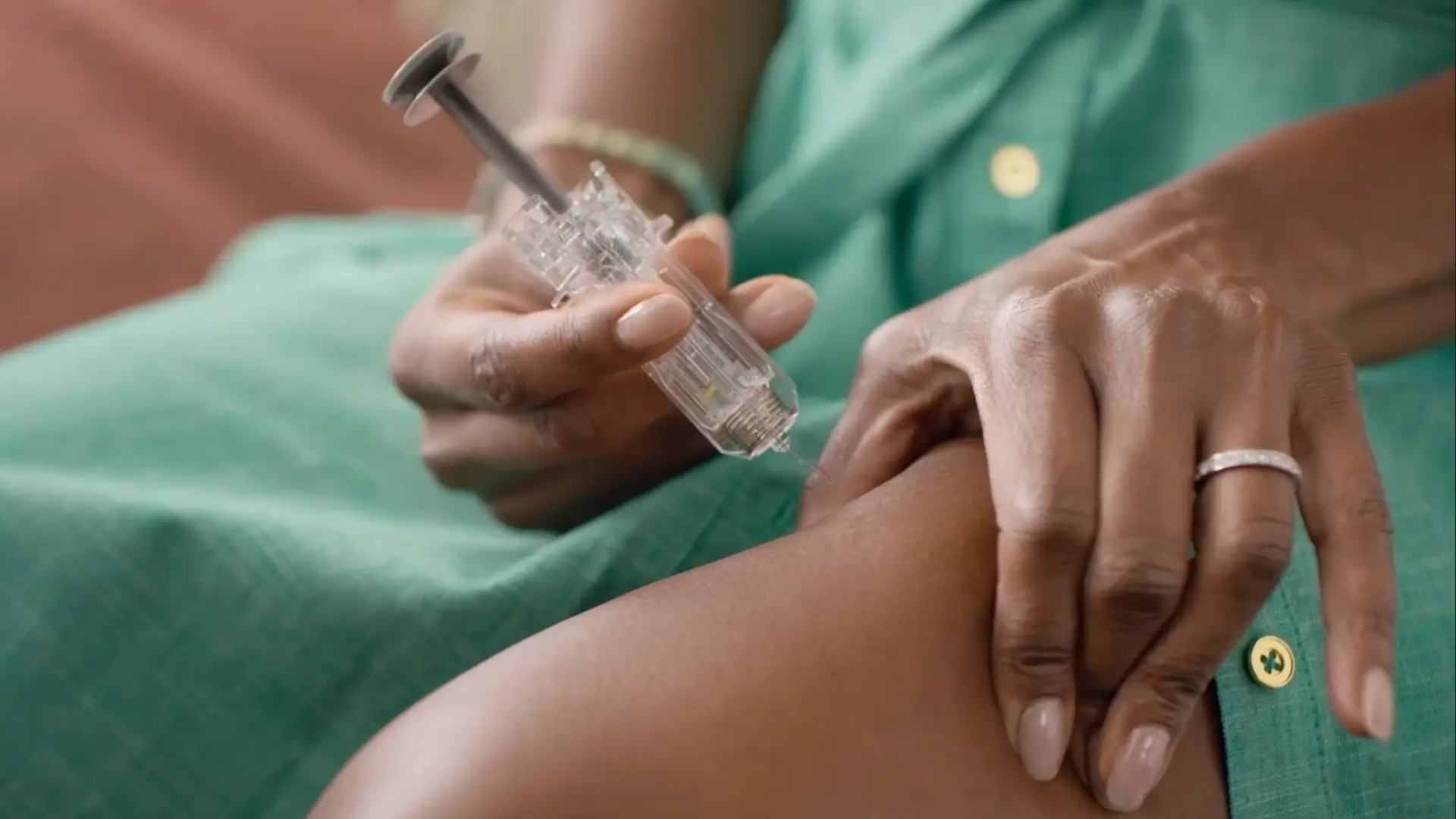Medications can have a range of side effects, some of which may lead to serious health issues. According to the CDC, more than a million people are sent to U.S. emergency departments each year due to adverse drug events. One of the best ways to prevent these risks is through careful pre-treatment screening, which includes checking for allergies, contraindications, and potential drug interactions.
This is especially important when starting biologic therapies like omalizumab (Xolair), as they carry a risk of serious reactions, including anaphylaxis. By reviewing a patient’s medical history, allergies, and current medications, healthcare providers can better anticipate potential risks and have informed conversations with patients about their treatment options.
In this article, we will walk you through a detailed list of Xolair’s side effects, discuss when they are most likely to occur, and share key strategies for monitoring and managing these effects.
Key Takeaways
- Xolair is approved for moderate-to-severe persistent asthma, chronic spontaneous urticaria (CSU), and chronic rhinosinusitis with nasal polyps (CRSwNP). It can also reduce the risk of allergic reactions, including anaphylaxis, in patients with IgE-mediated food allergies.
- Common side effects include injection-site reactions, headache, fatigue, fever, joint pain, and upper abdominal pain.
- Serious side effects, although rare, can include anaphylaxis, vasculitis, parasitic infections, and thrombocytopenia.
- Prompt action is needed if severe reactions occur, such as difficulty breathing, hypotension, angioedema, or rash.
- Xolair may alter immune responses and is associated with parasitic infections and potential malignancy, requiring ongoing monitoring.
- Proper screening before starting treatment and regular follow-ups are essential to minimize risks and manage potential side effects.
About: Medica Depot is your trusted all-in-one supplier, offering a range of high-quality medical injectables and supplies. If you’re looking to buy Xolair, contact Medica Depot’s sales representatives and they will guide you on how to do so. Whether for health professionals, plastic surgeons, dermatologists, licensed estheticians, or other specialists, we can offer genuine, brand-name products you may need. With Medica Depot, we prioritize serving you better to improve the patient’s quality of life.
Common Injection-Site and Systemic Reactions to Xolair (omalizumab)

Xolair (omalizumab injection) has passed a thorough US FDA approval process, highlighting its proven safety and efficacy for a variety of conditions. The medication is indicated for moderate to severe persistent asthma, chronic spontaneous urticaria (CSU, known before as chronic idiopathic urticaria), chronic rhinosinusitis with nasal polyps (CRSwNP), and to reduce allergic reactions, including anaphylaxis, in patients with IgE-mediated food allergies.
While Xolair has demonstrated significant therapeutic benefits, patients need to be aware that, like all medications, it can cause side effects. Consulting with a healthcare provider helps ensure patients fully understand the potential risks associated with Xolair, allowing for informed treatment decisions.
Children younger than 1 year old should not receive Xolair, even for food allergy or other allergic reaction. Adherence to the recommended age per indications can ensure a safe treatment. Furthermore, some of the most commonly reported Xolair side effects include:
- Injection-site reactions: Pain, redness, swelling, or itching
- Headache
- Fatigue
- Fever
- Joint pain
- Upper abdominal pain
Most Xolair reviews from users tend to be positive, with many reporting mild injection-site reactions. These reactions are often manageable and may not require significant medical attention. Healthcare providers may recommend symptomatic treatment for these local reactions and advise patients to report any persistent or unusual symptoms for proper management.
Rare but Serious Adverse Effects and Clinical Management Strategies: Severe Allergic Reaction

Medical providers and patients must also know how and when to recognize the serious adverse effects that can occur with omalizumab treatment. Factors such as contraindications, improper administration, or incorrect dose can increase the risk of these severe reactions. This underscores the importance of pre-treatment screening to ensure that patients are suitable candidates for the treatment and adhere to the prescribed medication protocol.
Serious adverse effects that have been reported in Xolair’s safety data include:
- Inflammation of blood vessels
- Parasitic infections
- Heart and circulation problems
- Xolair anaphylaxis risk: Severe allergic reaction may show symptoms including bronchospasm, hypotension, syncope, angioedema, hives, or difficulty breathing
In the event of anaphylaxis, Xolair should be immediately discontinued, and the patient should receive prompt medical attention. Supportive care and symptom-directed therapy, such as corticosteroids or other immunosuppressive treatments, may be required.
A doctor should also consider consulting allergy and immunology or rheumatology specialists for complex immune reactions or suspected organ dysfunction.
Immunologic and Hematologic Reactions: Serum Sickness, Vasculitis, Thrombocytopenia
Omalizumab may also trigger immune-mediated systemic reactions, which patients should be made aware of. These reactions need appropriate management, reinforcing the importance of seeking medical attention from a trained doctor or professional.
- Serum sickness-like reactions: These immune-complex responses can include symptoms such as fever, joint pain, rash, and swollen lymph nodes, typically appearing days after exposure to the medication.
- Vasculitis and eosinophilic syndromes: Xolair has been associated with the new or worsening of small-vessel vasculitis and eosinophilic granulomatosis with polyangiitis (EGPA), a rare autoimmune disease, particularly during steroid tapering.
- Thrombocytopenia and bleeding signs: There have been reports of platelet drops associated with Xolair. Patients should be vigilant for unusual bruising, petechiae, or bleeding, and blood counts should be monitored when necessary.
Supportive care and symptom-directed therapy, including corticosteroids or other immunosuppressive treatments, may be needed in some cases. The doctor should also assess baseline blood counts and continue monitoring during treatment.
Long-Term Safety Data, Infection, and Malignancy Considerations in Xolair Use

Clinical trials and postmarketing surveillance identified a numerical excess of malignancies in some Xolair‑treated groups. However, no definitive causal link was proven, urging regulators and the label to treat malignancy as a signal that requires ongoing vigilance.
Clinical trials and postmarketing surveillance have highlighted a numerical excess of malignancies in some groups treated with Xolair. However, no definitive causal link has been established, and malignancy is considered a signal that requires ongoing vigilance. Healthcare providers should remain alert for any potential signs of malignancy in patients using Xolair.
Additionally, Xolair may alter immune responses and research has linked it to parasitic infections, especially in individuals at risk. Before starting treatment, healthcare providers should screen and treat high-risk patients and continue monitoring for new or worsening infections.
For long-term safety, active monitoring is crucial throughout treatment. Each doctor should report any suspected serious side effects to the manufacturer and regulatory authorities to support ongoing safety surveillance of Xolair.
Conclusion
Xolair (omalizumab) is a vital medication for managing conditions such as asthma and allergies, with many patients reporting positive outcomes. However, it’s essential to be aware of the potential side effects, which can range from mild injection-site reactions to more serious complications like anaphylaxis.
Proper screening and ongoing monitoring are vital for those considering Xolair. Patients should maintain open communication with their healthcare providers, promptly report any unusual symptoms, and understand the risks and benefits of their treatment. By staying informed, patients can make confident, well-guided decisions regarding their Xolair treatment.
FAQs
1. What are the common side effects of Xolair?
Common side effects include injection-site reactions, headaches, fatigue, fever, joint pain, and upper abdominal pain. These can vary based on individual patient characteristics.
2. What should I do if I experience severe side effects while using Xolair?
If you experience severe side effects, such as anaphylaxis or severe hypersensitivity, discontinue Xolair immediately and seek emergency medical attention.
3. Why is screening important before starting Xolair treatment?
Screening helps identify contraindications and potential allergic reactions. It ensures that patients are suitable for Xolair treatment and minimizes the risk of adverse effects.
References
TUFTS Health Plan. Why Is It Important To Take Medicine Correctly? www.tuftsmedicarepreferred.org. Accessed October 24, 2025. https://www.tuftsmedicarepreferred.org/using-your-plan/why-it-important-take-medicine-correctly
Genentech Inc. XOLAIR® (Omalizumab) HIGHLIGHTS of PRESCRIBING INFORMATION. Genentech Inc. Accessed October 24, 2025. https://www.gene.com/download/pdf/xolair_prescribing.pdf









